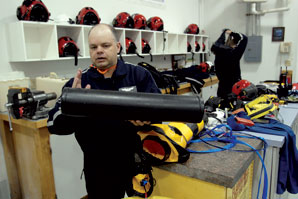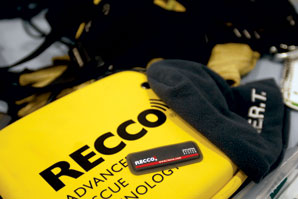The ALERT helicopter climbed vertically above the air ambulance program’s hangar, and the rest of the Kalispell Regional Medical Center complex. Though harnessed internally, a paramedic held, outside the open door of the chopper, a square, yellow hand piece pointed down at the ground, toward a small chip laying on the launch pad.
As if in an elevator, the chopper continued its slow ascent, until, hundreds of feet off the deck, the paramedic eventually lost the signal bouncing off of the RECCO chip on the ground. He nodded to the pilot, and the aircraft turned southwest toward Blacktail Mountain, where the crew would engage in another training exercise with one of two new, state-of-the-art search tools the ALERT helicopter program will deploy beginning this winter to aid in the rescue of avalanche victims in northwest Montana.
ALERT’s nurses, paramedics and pilots spent much of last week training on the two new systems, which should improve rescuers’ chances of locating avalanche victims. But it will also likely change the role the ALERT program plays in rescues: from that of providing care for avalanche victims once they are located by teams on the ground, to assisting in the search for buried victims as well.
 |
|
Rocco Altobelli, an ALERT Flight Paramedic, describes how the new avalanche antenna works to locate personal beacons during a training session at the ALERT center at Kalispell Regional Medical Center. Because the antenna is larger than a personal beacon the receiving range is much greater. |
“Our ability to help out with the rescue resources will increase,” Rocco Altobelli, an ALERT flight paramedic, said. “We’ll probably start getting called earlier than we were in the past because of that increased capability.”
Having a helicopter search an avalanche path from the air should make for a more efficient search, allowing rescue crews on the ground to zero in on the victims’ locations and begin digging for them – as opposed to beginning at the top of a slide path and painstakingly working their way down.
“We can search a much larger area much faster,” Altobelli added.
The recent acquisition of these search tools makes ALERT one of three helicopter services in the United States to possess and use such technology, and the only one in Montana. The expanded capabilities consist of two separate systems, the first of which is the, “Barryvox VS 2000 Pro EXT,” a large, cylindrical antenna that hangs below the chopper during flight and greatly improves rescuers’ ability to detect signals from traditional, personal transceivers buried in an avalanche.
The ALERT team also learned how to search with a RECCO system, where rescuers in the chopper use a handheld detector to bounce a radio signal off a tiny reflector containing diodes. These RECCO reflectors are increasingly stitched onto the clothing or equipment of backcountry travelers, from skiers to snowmobilers.
The Barryvox can search a range of nearly 300 feet, compared to personal beacons, which typically search a range anywhere from 30 to 90 feet wide. The RECCO’s range is about 100 feet, though that’s dependent on the depth of burial and water content of the snow, according to Manuel Genswein, one of the world’s foremost avalanche experts, who traveled to Kalispell from Switzerland last week to run the training session on the equipment.
But figuring out how to deploy the Barryvox and RECCO in the most effective way possible is far from simple, as the ALERT crew discovered last week. Because the two search tools are capable of picking up on such faint signals, avionic systems in the helicopter’s cockpit can sometimes interfere. The ALERT crew had to figure out the minimum amount of avionics possible to safely fly the helicopter without confusing signals.
“For most of our crew this is brand new stuff,” Altobelli said. “Maintaining proficiency is going to require training.”
 |
|
A small RECCO reflector is seen on a table at the ALERT Air Ambulance center at Kalispell Regional Medical Center. The reflector is becoming a common installment to winter clothing, boots and helmets. The RECCO system uses a transmitter to “bounce” a radio signal off diodes in the reflector. |
Key to employing the search tools was determining how they could be suspended from, or attached to, the chopper in a redundant way, so the RECCO handset can’t be dropped out of the cockpit if the searcher loses their grip. Should that require new mounting hardware on the outside of the helicopter, gaining approval from the Federal Aviation Administration is necessary.
When searching, the ALERT helicopter will hover about 30 feet off the ground, sweeping back and forth in a grid pattern across the slide path, according to ALERT Pilot Matt Weller, and that can be tough on mountainous terrain with rocks and trees.
“It’s important to make sure that you get complete coverage,” Weller, a former Coast Guard pilot with experience rescuing victims on open water, said. “You can’t just do a perfect square, but the sensitivity is pretty good on these things.”
Also complicating the air search is the likelihood that rescuers on the ground will be wearing transceivers and potentially clothing with RECCO reflectors. To head off any issues, the ALERT crew plans to train with groups like the Flathead County Sheriff’s Office, Big Mountain Ski Patrol and the Flathead Nordic Ski Patrol to coordinate air and ground avalanche searches.
“It’s going to be a team effort with those guys,” Altobelli said.
He and the rest of the ALERT team emphasized that while this new technology improves the resources of avalanche rescue teams, in no way is it a substitute for being properly trained to travel in avalanche terrain, and to know how to use personal avalanche equipment. The chances of a victim surviving an avalanche if not found after the first 15 minutes begin to decrease steeply, and according to Altobelli, the ALERT chopper arriving on the scene 15 to 30 minutes after an accident is a “best-case scenario” dependent on location.
“We’re going to come if we can, but avalanches tend to occur in weather that is really poor for helicopters to fly in,” he said. “The bottom line is that people need to be self-sufficient in the backcountry.”
Greg Fortin, owner of Glacier Adventure Guides and an avalanche adviser on the Flathead Nordic Ski Patrol, attended a three-hour session on proficiency with the new systems, along with the ALERT crew and fellow ski patrollers taught by Genswein last week. Acknowledging the potential limitations of it, Fortin also noted ALERT gaining the capability to search avalanches could allow for faster scans of slide paths, and the potential to get into remote locations while teams are still assembling on the ground.
“Maybe it will help protect rescuers and speed up the process of finding somebody,” Fortin said. “Just like everything else, it’s going to take training to do it effectively and do it safely.”
“I’m pretty excited that ALERT has got this,” Fortin added.